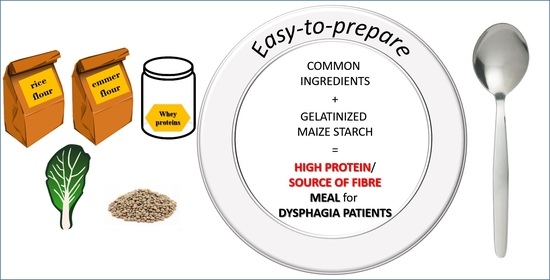Rheological and Nutritional Assessment of Dysphagia—Oriented New Food Preparations
Abstract
1. Introduction
2. Materials and Methods
2.1. Materials
2.2. Chemical Composition Analyses
2.3. Essential Amino Acids Analysis
2.4. Rheological Characterization
2.5. Statistical Analysis
3. Results
3.1. Nutritional Aspects of Innovative Formulations
3.2. Rheological Behavior: Rotational Tests
3.3. Rheological Behavior: Oscillatory Tests
4. Conclusions
Supplementary Materials
Author Contributions
Funding
Informed Consent Statement
Data Availability Statement
Conflicts of Interest
References
- DeFabrizio, M.E.; Rajappa, A. Contemporary approaches to dysphagia management. J. Nurse Pract. 2010, 6, 622–630. [Google Scholar] [CrossRef]
- Ekberg, O. Dysphagia: Diagnosis and Treatment; Springer Science & Business Media: Berlin/Heidelberg, Germany, 2012. [Google Scholar]
- Gallegos, C.; Brito-de la Fuente, E.; Clavé, P.; Costa, A.; Assegehegn, G. Chapter Eight—Nutritional Aspects of Dysphagia Management. In Advances in Food and Nutrition Research; Toldrá, F., Ed.; Academic Press: Cambridge, MA, USA, 2017; Volume 81, pp. 271–318. [Google Scholar]
- Germain, I.; Dufresne, T.; Gray-Donald, K. A novel dysphagia diet improves the nutrient intake of institutionalized elders. J. Am. Diet. Assoc. 2006, 106, 1614–1623. [Google Scholar] [CrossRef]
- Wright, L.; Cotter, D.; Hickson, M. The effectiveness of targeted feeding assistance to improve the nutritional intake of elderly dysphagic patients in hospital. J. Hum. Nutr. Diet. 2008, 21, 555–562. [Google Scholar] [CrossRef]
- Barbon, C.E.; Steele, C.M. Thickened Liquids for Dysphagia Management: A Current Review of the Measurement of Liquid Flow. Curr. Phys. Med. Rehabil. Rep. 2018, 6, 220–226. [Google Scholar] [CrossRef] [PubMed]
- Monte, F.S.; da Silva-Júnior, F.P.; Braga-Neto, P.; Nobre e Souza, M.Â.; Sales de Bruin, V.M. Swallowing abnormalities and dyskinesia in Parkinson’s disease. Mov. Disord. 2005, 20, 457–462. [Google Scholar] [CrossRef]
- Whelan, K. Inadequate fluid intakes in dysphagic acute stroke. Clin. Nutr. 2001, 20, 423–428. [Google Scholar] [CrossRef]
- Riso, S.; Baj, G.; D’Andrea, F. Thickened beverages for dysphagic patients. Data and myth. Med. J. Nutr. Metab. 2008, 1, 15–17. [Google Scholar] [CrossRef]
- Zargaraan, A.; Rastmanesh, R.; Fadavi, G.; Zayeri, F.; Mohammadifar, M.A. Rheological aspects of dysphagia-oriented food products: A mini review. Food Sci. Hum. Wellness 2013, 2, 173–178. [Google Scholar] [CrossRef]
- Nakauma, M.; Ishihara, S.; Funami, T.; Nishinari, K. Swallowing profiles of food polysaccharide solutions with different flow behaviors. Food Hydrocoll. 2011, 25, 1165–1173. [Google Scholar] [CrossRef]
- Matta, Z.; Chambers IV, E.; Garcia, J.M.; Helverson, J.M. Sensory characteristics of beverages prepared with commercial thickeners used for dysphagia diets. J. Am. Diet. Assoc. 2006, 106, 1049–1054. [Google Scholar] [CrossRef] [PubMed]
- Wright, L.; Cotter, D.; Hickson, M.; Frost, G. Comparison of energy and protein intakes of older people consuming a texture modified diet with a normal hospital diet. J. Hum. Nutr. Diet. 2005, 18, 213–219. [Google Scholar] [CrossRef]
- De Villiers, M.; Hanson, B.; Moodley, L.; Pillay, M. The impact of modification techniques on the rheological properties of dysphagia foods and liquids. J. Texture Stud. 2020, 51, 154–168. [Google Scholar] [CrossRef] [PubMed]
- Nicosia, M.A.; Robbins, J. The usefulness of the line spread test as a measure of liquid consistency. Dysphagia 2007, 22, 306–311. [Google Scholar] [CrossRef] [PubMed]
- Casanovas, A.; Hernández, M.; Martí-Bonmatí, E.; Dolz, M. Cluster classification of dysphagia-oriented products considering flow, thixotropy and oscillatory testing. Food Hydrocoll. 2011, 25, 851–859. [Google Scholar] [CrossRef]
- Zarim, N.A.; Abidin, S.Z.; Ariffin, F. Rheological studies on the effect of different thickeners in texture-modified chicken rendang for individuals with dysphagia. J. Food Sci. Technol. 2018, 55, 4522–4529. [Google Scholar] [CrossRef]
- Sharma, M.; Kristo, E.; Corredig, M.; Duizer, L. Effect of hydrocolloid type on texture of pureed carrots: Rheological and sensory measures. Food Hydrocoll. 2017, 63, 478–487. [Google Scholar] [CrossRef]
- Cho, H.M.; Yoo, B. Rheological characteristics of cold thickened beverages containing xanthan gum–based food thickeners used for dysphagia diets. J. Acad. Nutr. Diet. 2015, 115, 106–111. [Google Scholar] [CrossRef]
- Association of Official Analytical Chemists. Official Methods of Analysis, 17th ed.; The Association of Official Analytical Chemists: Gaithersburg, MD, USA, 2000. [Google Scholar]
- American Association of Cereal Chemists. Approved Methods of AACC, 10th ed.; The Association: St. Paul, MN, USA, 2000. [Google Scholar]
- Otter, D.E. Standardised methods for amino acid analysis of food. Br. J. Nutr. 2012, 108, S230–S237. [Google Scholar] [CrossRef] [PubMed]
- FAO/WHO. Dietary protein quality evaluation in human nutrition. FAO Food Nutr. Pap. 2013, 92, 1–66. [Google Scholar]
- SINU. Livelli di Assunzione di Riferimento di Nutrienti ed energia per la popolazione italiana IV Revisione (LARN 2014). 2014. Available online: https://sinu.it/tabelle-larn-2014/ (accessed on 12 January 2021).
- Roland, W.S.; Pouvreau, L.; Curran, J.; van de Velde, F.; de Kok, P.M. Flavor aspects of pulse ingredients. Cereal Chem. 2017, 94, 58–65. [Google Scholar] [CrossRef]
- De Aguilar-Nascimento, J.E.; Silveira, B.R.P.; Dock-Nascimento, D.B. Early enteral nutrition with whey protein or casein in elderly patients with acute ischemic stroke: A double-blind randomized trial. Nutrition 2011, 27, 440–444. [Google Scholar] [CrossRef]
- European Commission. Regulation (EC) No. 1924/2006 of the European Parliament and of the Council of 20 December 2006 on Nutrition and Health Claims made on Foods. J. Eur. Union 2006, L404, 9–25. [Google Scholar]
- European Commission. 2016/1413 of 24 August 2016 amending Regulation (EU) No 432/2012 establishing a list of permitted health claims made on foods other than those referring to the reduction of disease risk and to children’s development and health. J. Eur. Union 2016, L230, 8–15. [Google Scholar]
- Cuomo, F.; Iacovino, S.; Cinelli, G.; Messia, M.C.; Marconi, E.; Lopez, F. Effect of additives on chia mucilage suspensions: A rheological approach. Food Hydrocoll. 2020, 109, 106118. [Google Scholar] [CrossRef]
- Mezger, T. The Rheology Handbook: For Users of Rotational and Oscillatory Rheometers; Vincentz Network GmbH & Co KG: Hannover, Germany, 2006. [Google Scholar]
- American Dietetic Association; South Suburban Dietetic Association; Dietitians of Canada. Manual of Clinical Dietetics; American Dietetic Association: Chicago, IL, USA, 2000. [Google Scholar]
- Cichero, J.A.Y.; Lam, P.; Steele, C.M.; Hanson, B.; Chen, J.; Dantas, R.O.; Duivestein, J.; Kayashita, J.; Lecko, C.; Murray, J.; et al. Development of International Terminology and Definitions for Texture-Modified Foods and Thickened Fluids Used in Dysphagia Management: The IDDSI Framework. Dysphagia 2017, 32, 293–314. [Google Scholar] [CrossRef]
- National Dysphagia Diet Task Force. National Dysphagia Diet: Standardization for Optimal Care. American Dietetic Association: Chicago, IL, USA, 2002. [Google Scholar]
- Patel, A.R.; Dumlu, P.; Vermeir, L.; Lewille, B.; Lesaffer, A.; Dewettinck, K. Rheological characterization of gel-in-oil-in-gel type structured emulsions. Food Hydrocoll. 2015, 46, 84–92. [Google Scholar] [CrossRef]
- Talens, P.; Castells, M.; Verdú, S.; Barat, J.; Grau, R.J.J.o.F.E. Flow, viscoelastic and masticatory properties of tailor made thickened pea cream for people with swallowing problems. J. Food Sci. Eng. 2021, 292, 110265. [Google Scholar] [CrossRef]
- Ishihara, S.; Nakauma, M.; Funami, T.; Odake, S.; Nishinari, K. Swallowing profiles of food polysaccharide gels in relation to bolus rheology. Food Hydrocoll. 2011, 25, 1016–1024. [Google Scholar] [CrossRef]
- Steele, C.M.; Alsanei, W.A.; Ayanikalath, S.; Barbon, C.E.; Chen, J.; Cichero, J.A.; Coutts, K.; Dantas, R.O.; Duivestein, J.; Giosa, L. The influence of food texture and liquid consistency modification on swallowing physiology and function: A systematic review. Dysphagia 2015, 30, 2–26. [Google Scholar] [CrossRef]
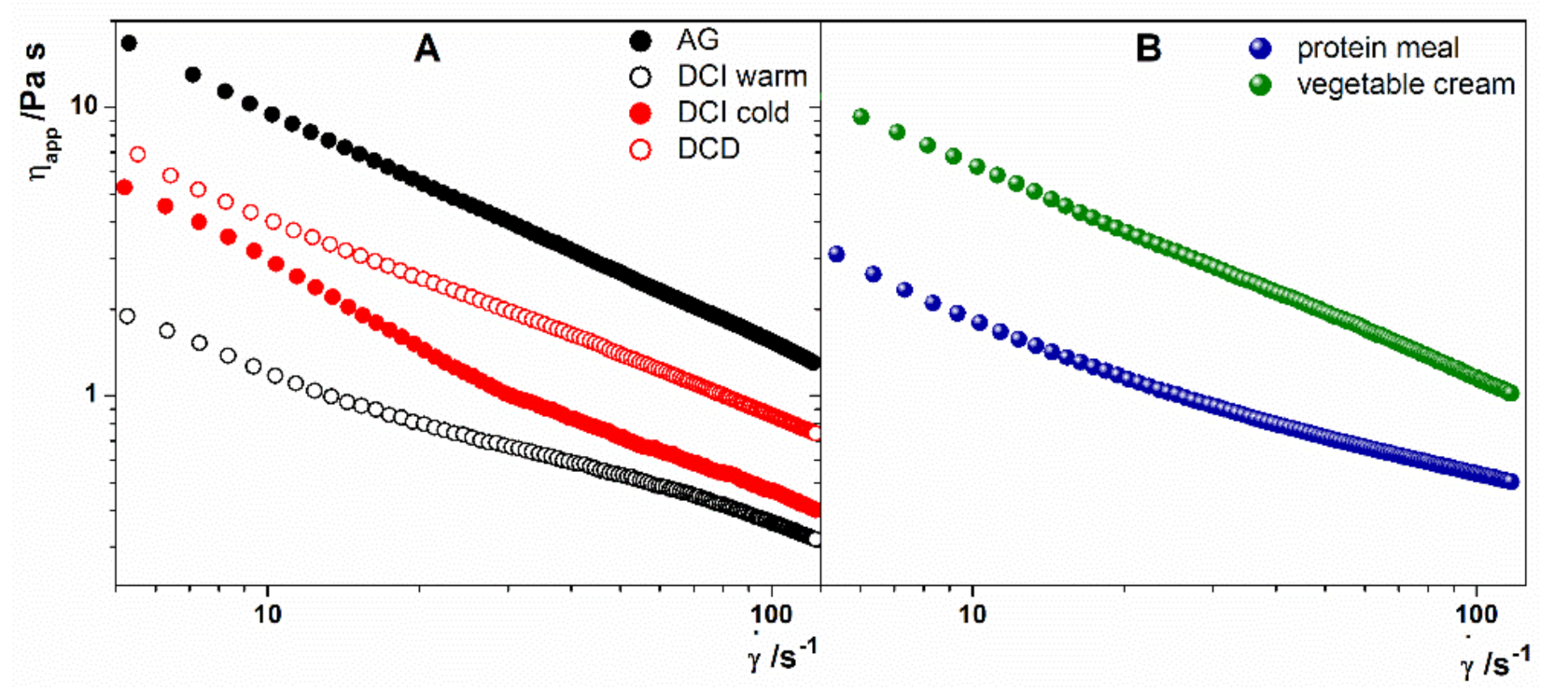
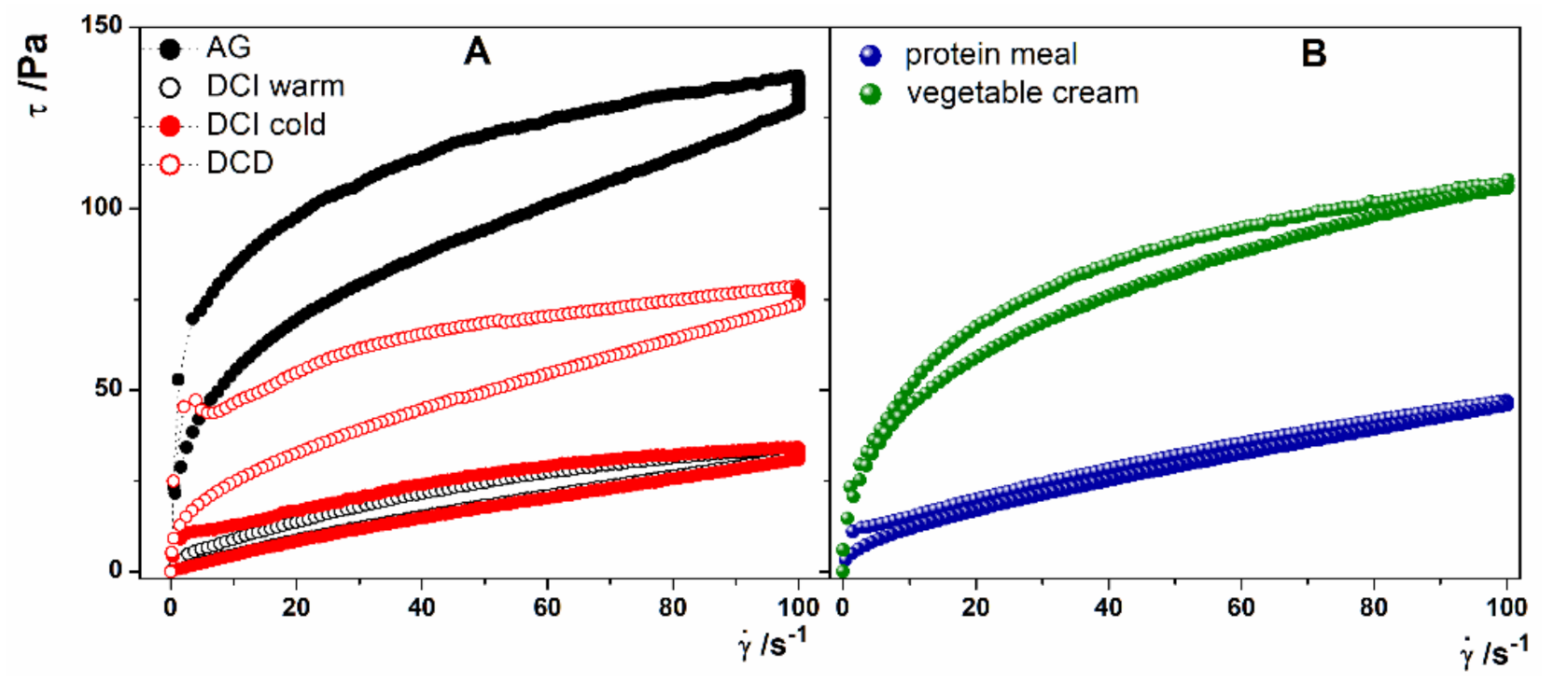
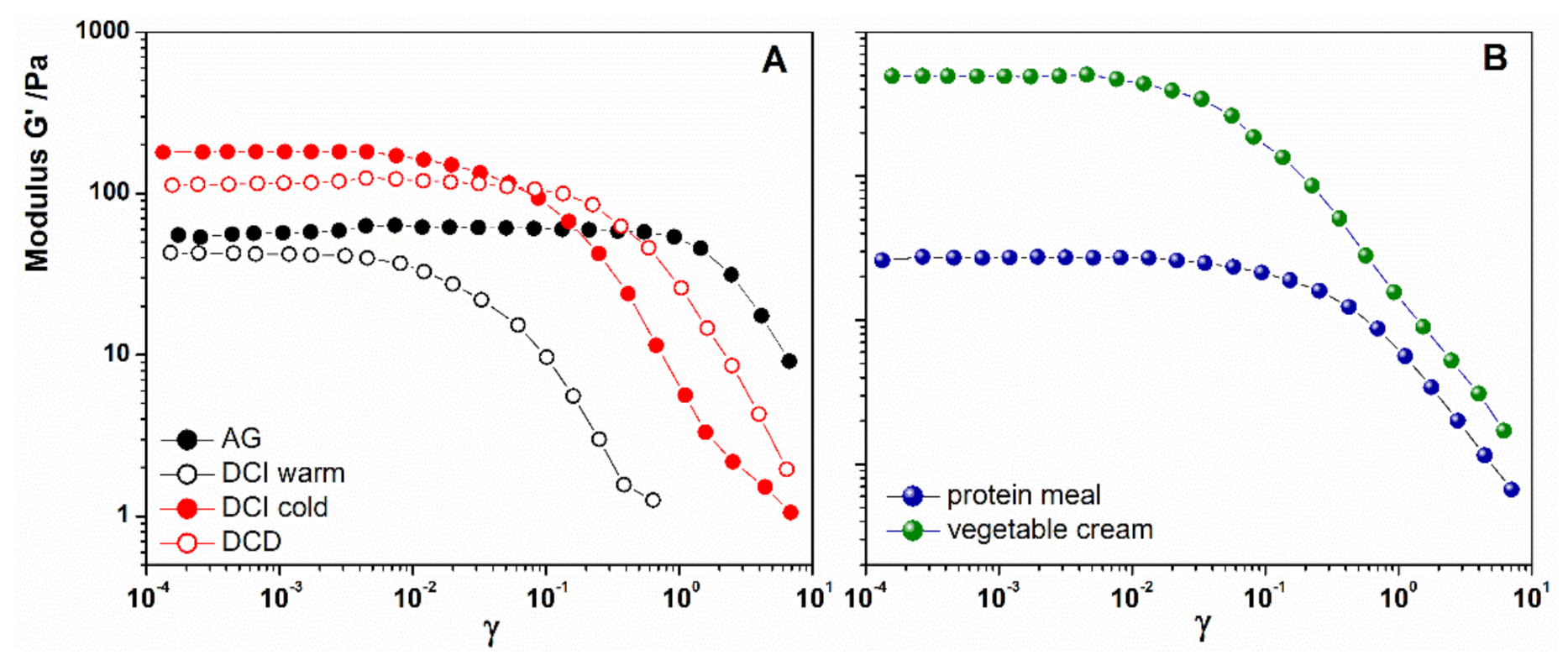
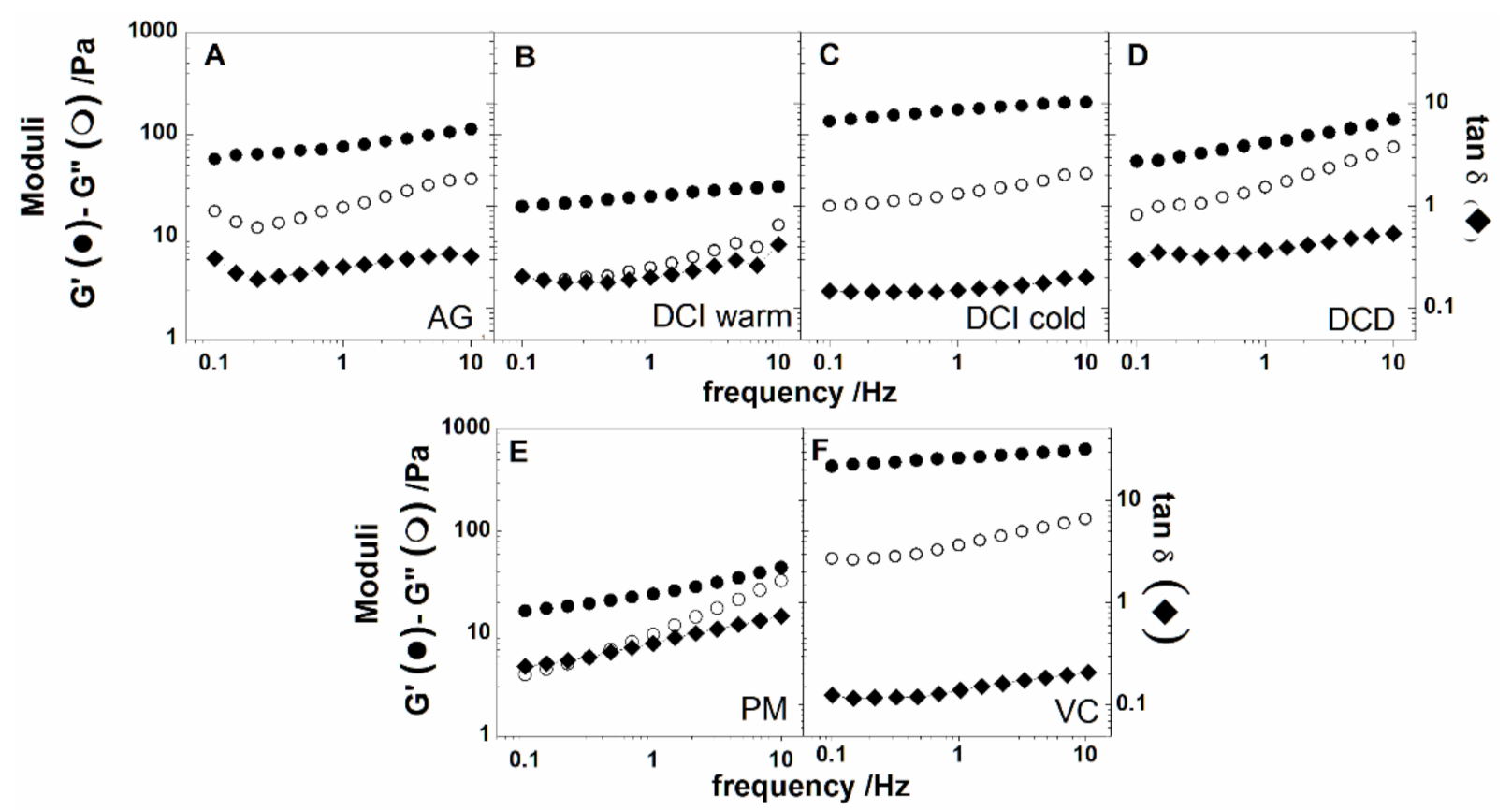
| AM Gel (AG) | Delical Cereal Instant (DCI) | Delical Cream Dessert (DCD) | |
|---|---|---|---|
| Energy | 15 kJ/4 kcal | 1687 kJ/400 kcal | 635 kJ/150 kcal |
| Fat, total | <0.5 g | 9.9 g | 4.9 g |
| -saturated | 0.0 g | 1.5 g | 0.3 g |
| Carbohydrate | <0.5 g | 57.6 g | 16.7 g |
| -sugar | 0.0 g | 19.5 g | 12.2 g |
| Fiber | 1.2 g | 6.0 g | 0.0 g |
| Protein | <0.5 g | 20.1 g | 10.0 g |
| Salt | 0.07 g | 0.83 g | 0.1 g |
| Ingredients (%) | PM | VC |
|---|---|---|
| Instant rice flour | 65.5 | 0 |
| Instant emmer flour | 10 | 0 |
| Dried whey protein | 20 | 0 |
| Gelatinized maize starch | 4.5 | 8 |
| Chard puree | 0 | 37 |
| Pureed lentils | 0 | 55 |
| PM | VC | |
|---|---|---|
| Moisture | 6.7 ± 0.05 | 85.0 ± 0.02 |
| Fat | 1.6 ± 0.02 | 0.3 ± 0.01 |
| Carbohydrate * | 66.3 | 17.6 |
| Fiber | 1.8 ± 0.10 | 3.20 ± 0.08 |
| Protein | 21.9 ± 0.12 | 4.1 ± 0.05 |
| Ash | 1.65 ± 0.04 | 0.74 ± 0.05 |
| Energy kJ/kcal | 1573/371 | 405/94 |
| Essential Amino Acid | Rice Flour | Emmer Flour | Whey Proteins Powder | Protein Meal (PM) |
|---|---|---|---|---|
| Histidine | 2.50 ± 0.02 | 2.11 ± 0.01 | 2.13 ± 0.03 | 1.96 ± 0.05 |
| Isoleucine | 4.10 ± 0.05 | 3.42 ± 0.02 | 7.12 ± 0.10 | 5.89 ± 0.10 |
| Leucine | 8.20 ± 0.10 | 6.80 ± 0.05 | 11.35 ± 0.55 | 9.83 ± 0.42 |
| Lysine | 3.48 ± 0.23 | 2.13 ± 0.03 | 9.83 ± 0.13 | 7.49 ± 0.10 |
| Methionine | 2.42 ± 0.00 | 1.58 ± 0.02 | 2.25 ± 0.09 | 2.18 ± 0.19 |
| Cystine | 1.80 ± 0.21 | 2.00 ± 0.10 | 2.51 ± 0.21 | 2.13 ± 0.15 |
| Phenylalanine | 5.33 ± 0.11 | 4.89 ± 0.10 | 3.44 ± 0.28 | 3.76 ± 0.05 |
| Tyrosine | 5.28 ± 0.08 | 2.56 ± 0.04 | 3.42 ± 0.56 | 3.41 ± 0.22 |
| Threonine | 3.53 ± 0.21 | 2.81 ± 0.00 | 7.72 ± 0.02 | 5.80 ± 0.00 |
| Valine | 5.85 ± 0.02 | 4.14 ± 0.04 | 6.65 ± 0.23 | 5.65 ± 0.32 |
| Tryptophan | 1.21 ± 0.42 | 1.00 ± 0.04 | 1.93 ± 0.04 | 1.34 ± 0.10 |
| Chemical Score (CS) | 77 | 44 | 100 | 100 |
| Limiting amino acid | Lysine | Lysine | - | - |
| Formulation | ηapp/Pa s | Category |
|---|---|---|
| AG | 2.60 | Spoon-like |
| DCI warm | 0.42 | Honey-like |
| DCI cold | 0.84 | Honey-like |
| DCD | 1.17 | Honey-like |
| PM | 1.90 | Spoon-like |
| VC | 3.30 | Spoon-like |
Publisher’s Note: MDPI stays neutral with regard to jurisdictional claims in published maps and institutional affiliations. |
© 2021 by the authors. Licensee MDPI, Basel, Switzerland. This article is an open access article distributed under the terms and conditions of the Creative Commons Attribution (CC BY) license (http://creativecommons.org/licenses/by/4.0/).
Share and Cite
Cuomo, F.; Angelicola, M.; De Arcangelis, E.; Lopez, F.; Messia, M.C.; Marconi, E. Rheological and Nutritional Assessment of Dysphagia—Oriented New Food Preparations. Foods 2021, 10, 663. https://doi.org/10.3390/foods10030663
Cuomo F, Angelicola M, De Arcangelis E, Lopez F, Messia MC, Marconi E. Rheological and Nutritional Assessment of Dysphagia—Oriented New Food Preparations. Foods. 2021; 10(3):663. https://doi.org/10.3390/foods10030663
Chicago/Turabian StyleCuomo, Francesca, Martina Angelicola, Elisa De Arcangelis, Francesco Lopez, Maria Cristina Messia, and Emanuele Marconi. 2021. "Rheological and Nutritional Assessment of Dysphagia—Oriented New Food Preparations" Foods 10, no. 3: 663. https://doi.org/10.3390/foods10030663
APA StyleCuomo, F., Angelicola, M., De Arcangelis, E., Lopez, F., Messia, M. C., & Marconi, E. (2021). Rheological and Nutritional Assessment of Dysphagia—Oriented New Food Preparations. Foods, 10(3), 663. https://doi.org/10.3390/foods10030663






